WSU, PNNL researchers develop viable sodium battery
Green Car Congress
JUNE 2, 2020
O 2 –hard carbon full-cells with practical loading (>2.5 Sodium-ion batteries (SIBs), with the intrinsic advantages of resource abundance and geographic uniformity, are desired alternative battery technology to Li-ion batteries (LIBs) for grid-scale energy storage and transportation applications. mAh cm –2 ) and lean electrolyte (?40








































Let's personalize your content